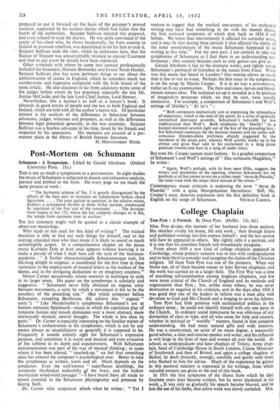Forensic Memoirs
The Last Serjeant. By Serjeant A. M. Sullivan. (Macdonald. 21S.)
THE ancient order of serjeants-at-law was formerly one of the highest rank of barristers. The serjeants had their own inn-of-court, Serjeants' Inn, and when robed they wore the coif, a round piece of black silk attached to their wigs, which distinguished them from other members of the Bar in court. The last barrister to wear the coif in England was Serjeant Sullivan, who retired from practice a few years ago and has now produced an attractive book of memoirs.
After the fusion of the various English courts into the High Court of Justice by the Judicature ,Act of 1873, no more serjeants were appointed in England. It was otherwise in Ireland, where they were seen in the courts until the creation of the Irish Free State in 1922. Serjeant Sullivan was appointed while at the Irish Bar. When he came to London to set up in practice anew at the age of fifty at the end of the First World War, he was granted special permission to use the style and rank of serjeant. Serjeant Sullivan has enjoyed a full and varied life, and he gives the reader much of its spice in his book.. The son of an Irish Nationalist M.P., he was brought up in New York where he first worked as a journalist. He returned to Ireland in the early 'nineties to be called to the Bar in Dublin and to practise there with con- siderable success for more than a quarter of a century. He first came into prominence in England through his spectacular but unsuccessful defence of Sir Roger Casement on a charge of treason at the Old Bailey in 1916. One of the most interesting chapters in his book is devoted to the Casement trial. He reveals for the first time that the Crown was prepared to accept a plea of "guilty but insane," had he been prepared to put it forward on the basis of the prisoner's proved conduct, supported by his curious diaries which had fallen into the hands of the authorities. Serjeant Sullivan rejected this proposal, and even refused to read the diaries. He was quite convinced of the sanity of his client who, he shows incidentally, far from coming to Ireland to promote rebellion, was determined to do his best to stop it. Serjeant Sullivan took the view, which he elaborates here, that the Statute of Treason was unwarrantably strained to convict Casement and that in any event he should have been reprieved.
Other criminals with whom he came into contact professionally included the financiers, Horatio Bottomley and Ernest Terah Hooley. Serjeant Sullivan also has some pertinent things to say about the administration of justice in England, which he considers much too cumbersome and expensive compared with the Irish brand of the same article. He also discusses in far from adulatory terms some of the judges before whom he has practised, especially the late Mr. Justice McCardie and the late Lord Chief Justice, Lord Hewart.
Nevertheless, this a layman's as well as a lawyer's book. It abounds in good stories of people and the law in both England and Ireland, which are told with all the author's native wit. Of particular interest is his analysis of the differences in behaviour between advocates, judges, witnesses and prisoners, as well as the differences between legal procedure generally, in the two countries. Serjeant Sullivan was a fearless advocate in his time, loved by his friends and respected by his opponents. His memoirs are assured of a per- manent place in the library of British forensic literature.
H. MONTGOMERY HYDE.



































 Previous page
Previous page